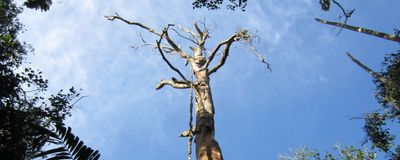plant science

Harnessing Molecular Farming’s Potential
Priyom Bose, PhD | Sep 5, 2024 | 8 min read
Molecular farming is a promising technique that enables the production of biopharmaceuticals and other high value compounds in plants.

Can Plants See? In the Wake of a Controversial Study, the Answer’s Still Unclear
Christie Wilcox, PhD | Nov 30, 2022 | 10+ min read
A tiny pilot study found that so-called chameleon vines mimicked plastic leaves, but experts say poor study design and conflicts of interest undermine the report.

Climate Change May Favor Nitrogen-Fixing Plants
Andy Carstens | Oct 17, 2022 | 2 min read
Aridity appears to configure landscapes with a greater diversity of plant species that rely on symbiotic bacteria for nitrogen.

Meet the Algae That Went from Male/Female to Hermaphroditic
Natalia Mesa, PhD | Aug 1, 2022 | 2 min read
A study suggests that several species of brown algae may have independently evolved to express both sexes simultaneously, and it’s likely that female algae evolved male traits—not the other way around.

Trees’ Scent Tricks Hornets Into Shuttling Seeds
Natalia Mesa, PhD | Jun 30, 2022 | 4 min read
Agarwood fruit smells like prey, luring carnivorous hornets, a study suggests.

The Right Chemistry, 1935
Catherine Offord | Mar 1, 2022 | 3 min read
Percy Lavon Julian, a young, Black scientist working in Jim Crow America, gained international recognition after beating chemists at the University of Oxford in the race to synthesize the alkaloid physostigmine, used for decades as a treatment for glaucoma.

Canada Approves World’s First Plant-Based COVID-19 Vaccine
Natalia Mesa, PhD | Feb 25, 2022 | 2 min read
Canada has ordered 76 million doses of Covifenz, the main ingredient of which was manufactured in the leaves of a tobacco relative.

Sunflowers’ Bee-Attracting Ultraviolet Also Helps Retain Moisture
Natalia Mesa, PhD | Feb 8, 2022 | 5 min read
The dual purposes of the plants’ hidden colors may conflict as the climate warms, authors of a new study suggest.

La Botaniste, 1810–1865
Sukanya Charuchandra | Jan 4, 2022 | 2 min read
Elaborate annotations hidden in a copy of Sir James Edward Smith’s The English Flora hinted at the life of a mysterious woman botanist.

Contrary to Common Belief, Some Older Trees Make Fewer Seeds
Annie Melchor | Nov 1, 2021 | 2 min read
An analysis of more than half a million trees reveals that many species begin to taper off seed production once they hit a certain size.

Hybrid Rice Developer Yuan Longping Dies at 90
Lisa Winter | May 26, 2021 | 2 min read
The high-yield variety of rice he produced in the 1970s prevented countless people from dying of starvation.

Dick Staples, Plant Pathologist, Dies at 94
Asher Jones | Feb 1, 2021 | 3 min read
The Boyce Thompson Institute researcher’s work revealed key insights into how plant pathogens recognize and colonize their hosts.

William Danforth, Longtime Research Philanthropist, Dies at 94
Max Kozlov | Sep 22, 2020 | 4 min read
Danforth founded the Donald Danforth Plant Science Center and expanded scientific research at Washington University and beyond campus in St. Louis.

Enter a Ghost Forest
The Scientist | Mar 1, 2020 | 1 min read
Take a tour of a forest killed by salt inundation brought by rising seas—a powerful reminder that climate change is affecting ecosystems around the world.

Sowing Seeds of Change
The Scientist | Mar 1, 2020 | 1 min read
Watch Profilee Joanne Chory deliver a TED talk on her project to breed climate change–busting plants.

Book Excerpt from Tree Story
Valerie Trouet | Mar 1, 2020 | 3 min read
In Chapter 5, “The Messiah, the Plague, and Shipwrecks under the City,” author Valerie Trouet tells the tale of wooden structures crafted by Europeans millennia ago and how dendrochronology helped determine their age.

Confessing to Plant Blindness
Bob Grant | Mar 1, 2020 | 3 min read
I have taken plants for granted. I pledge to change.

Opinion: Tree Rings as Soothsayers
Valerie Trouet | Mar 1, 2020 | 3 min read
Not only can studying the growth patterns obscured within tree trunks tell us about the past, the field can also help us plan for the future.

The Scientist Infographics: Editor’s Picks of 2019
Jef Akst | Dec 18, 2019 | 3 min read
This year’s most beautiful illustrations covered topics including the molecular underpinnings of Parkinson’s disease and strategies for tracking marine organisms around the world’s oceans.
